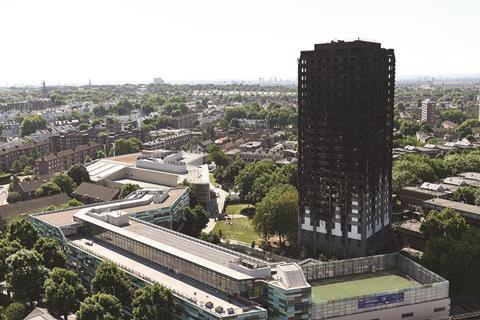Institute demands immediate ban on combustible materials

The RIBA has criticised the Hackitt Review for not imposing an immediate ban on combustible materials in the construction of high rise buildings.
Judith Hackitt’s investigation, launched as a result of the Grenfell fire tragedy, should have gone much further, said the institute’s immediate past president Jane Duncan.
The interim report published today should, as a “matter of great urgency”, have made real and meaningful change to the core building regulations guidance covering fire safety, she said.
The failure to include an immediate prohibition on the use of combustible materials in the external wall construction of high-rises leaves the industry in ongoing uncertainty, added Duncan who is chair of the RIBA’s expoer advisory group on fire safety.
The RIBA was also disappointed that the 24-page report did not include a greater role for sprinklers as an active life safety measure in residential buildings.
Requirements for at least two staircases, offering alternative means of escape in blocks of flats, should also have been in the document, it said.
But the RIBA welcomed other aspects of the report, in particular Hackitt’s recognition that the current regulatory system is not fit for purpose and her suggestion that responsibility for fire safety should be given to a named individual or organisation.
Duncan said: “I’m pleased that Dame Judith Hackitt recognises the current regulatory system is not fit for purpose and that there is a lack clarity of roles and responsibilities in the construction industry.
“The RIBA’s expert advisory group on fire safety strongly recommends that the final review should require a named person or organisation to hold prime responsibility for the oversight of fire safety in the design and construction of any building project.
“It is disappointing that the interim review has not called for an immediate prohibition on the use any combustible materials in the external wall construction of high-rise buildings. This means we continue with this grey-area in regards to fire-safety.”
The good and the bad
The RIBA welcome that the report seeks:
Better definition and allocation of roles and responsibilities within the building and fire regulatory system, with defined duty holders. The RIBA hopes that the final report will require a named person or organisation with prime responsibility for oversight of fire-safe design and construction on any building project
:: Increased independent oversight of the quality of construction work
:: Stronger compliance and enforcement of building control
:: Raised levels of competence and accreditation of those involved in design, construction and maintenance of higher risk buildings
:: It is also good to see a recognition by Dame Judith of the importance of the ‘golden thread’ of original design intent, the integrity of which must be maintained in any building project or subsequent refurbishment – in order to avoid fragmentation of design responsibility with risks poorer quality outcomes.
The RIBA is disappointed that while the report recognises the complexity and lack of clarity in the current building regulations guidance, it shies away from introducing immediate and effective changes to the current fire safety guidance, Approved Document B. The RIBA would like to see:
:: An immediate prohibition on the use any combustible materials in the external wall construction of high-rise buildings
:: A greater role for sprinklers as an active life safety measure in residential buildings
:: Requirements for at least two staircases, offering alternative means of escape in high-rise residential buildings
The RIBA’s evidence to the Hackitt Review is here.













No comments yet